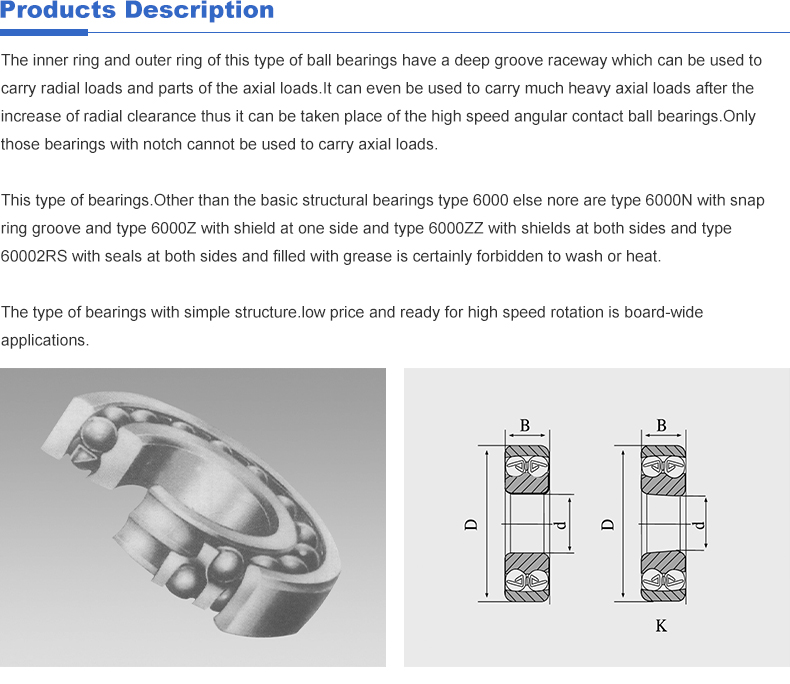
Nov . 26, 2024 18:39 Back to list
Pricing Analysis for Deep Groove Ball Bearings in the Market
Understanding the Pricing of Deep Groove Ball Bearings
Deep groove ball bearings are among the most widely used types of rolling bearings in various applications due to their versatility, durability, and ability to accommodate both radial and axial loads. As industries continue to evolve, so too does the demand for these essential components, leading to significant variations in pricing. Understanding the factors that influence the price of deep groove ball bearings is crucial for manufacturers, engineers, and purchasers alike.
Key Factors Influencing Price
1. Material Quality The materials used in manufacturing deep groove ball bearings play a significant role in determining their price. High-quality steel, such as chrome steel (AISI 52100), is commonly used due to its excellent hardness and fatigue resistance. Bearings made from superior materials typically come at a higher cost but offer better performance and longevity.
2. Precision and Tolerance Levels Deep groove ball bearings are available in various precision grades, often classified as ABEC (Annular Bearing Engineers' Committee) standards. Higher precision bearings, which are manufactured to tighter tolerances, cost more due to the additional processing and quality control involved in their production. These are often necessary in applications requiring high-speed operation or exact positioning.
3. Size and Design The size and design of the bearing also impact its pricing. Larger bearings generally cost more due to the increased material and manufacturing complexity involved. Additionally, specialized designs, such as those with integrated seals or shields to protect against contamination, may incur additional costs compared to standard versions.
deep groove ball bearing price

4. Brand and Manufacturer Reputation Establishing a brand reputation requires time and investment in quality assurance, which translates into higher prices for products from well-known manufacturers. Brands that are recognized for their reliability often command a premium, as customers associate them with high performance and longevity.
5. Quantity and Bulk Purchasing The pricing structure for deep groove ball bearings often includes discounts for bulk purchases. Purchasing in larger quantities can significantly lower the per-unit cost, making it economically advantageous for manufacturers needing substantial amounts of bearings for production lines.
6. Market Demand and Supply Dynamics Like many commodities, the pricing of deep groove ball bearings is influenced by market supply and demand. Situations such as economic booms or downturns can lead to fluctuations in prices. Additionally, if there are disruptions in the supply chain, it may cause prices to spike due to scarcity.
7. Geographical Factors Prices can vary significantly based on geographical location due to factors such as shipping costs, tariffs, and local market demand. For instance, purchasing deep groove ball bearings within regions that produce them may result in lower shipping costs, thereby affecting the overall price.
Conclusion
In conclusion, the price of deep groove ball bearings is influenced by a blend of material quality, precision levels, size and design intricacies, brand reputation, quantity purchased, market dynamics, and geographical location. For businesses and individuals looking to procure these critical components, it is essential to weigh these factors carefully. Understanding the cost implications can help in making informed purchasing decisions, ensuring that the right balance between quality and price is achieved. With the manufacturing landscape continually evolving, staying informed about these pricing factors will enable stakeholders to adapt and thrive in a competitive marketplace.
Latest news
-
Grooved Ball Bearing Design and Functionality
NewsJun.04,2025
-
Concrete Mixer Bearing Load Capacity Testing
NewsJun.04,2025
-
6004 Bearing Dimensions in Robotic Joint Designs
NewsJun.04,2025
-
Advantages of Single-Row Deep Groove Ball Bearings
NewsJun.04,2025
-
Applications of Deep Groove Ball Bearings in Automotive Systems
NewsJun.04,2025
-
Innovations in Bearing Pressing Machine Design
NewsJun.04,2025
